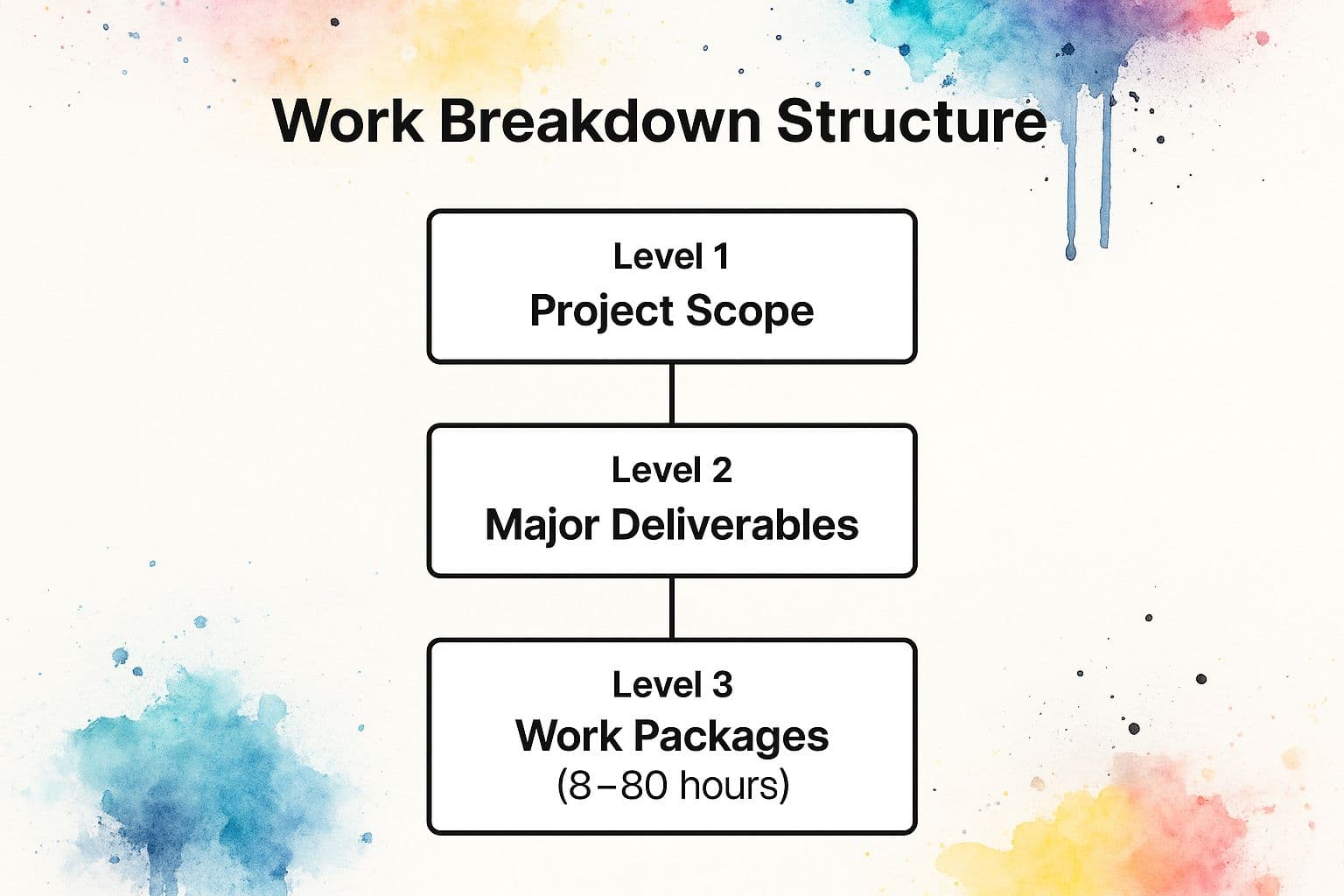Discover 6 proven project outline example templates. Learn how to structure any project, from Agile to Waterfall, for guaranteed success.
July 2, 2025 (5mo ago)
6 Powerful Project Outline Example Templates for 2025
Discover 6 proven project outline example templates. Learn how to structure any project, from Agile to Waterfall, for guaranteed success.
← Back to blog
A detailed project outline is the architectural blueprint for success, transforming a vague objective into a structured, actionable plan. It's the critical step that separates well-executed projects from those that drift into chaos, plagued by scope creep, missed deadlines, and budget overruns. Moving beyond a simple to-do list, a robust outline provides clarity, aligns stakeholders, and establishes a clear path from initiation to completion. It forces you to define goals, allocate resources, identify dependencies, and anticipate risks before committing significant time and capital.
This article showcases six distinct project outline example** frameworks, each tailored for different methodologies and goals. We will dissect each one, from the hierarchical Work Breakdown Structure to the iterative Agile Sprint Plan. You won't just see templates; you will gain a strategic understanding of why each structure works and how to adapt it for your specific needs. The goal is to equip you with the practical knowledge to select and customize the right outline, ensuring your next project is built on a solid foundation. You'll learn how to architect your initiatives with precision, providing your team with the direction needed to deliver results efficiently and effectively.
1. Work Breakdown Structure (WBS) Project Outline
The Work Breakdown Structure (WBS) is a foundational project management tool that provides a hierarchical decomposition of the total scope of work. It is not just a list of tasks; it is a comprehensive, deliverable-oriented breakdown of a project into smaller, more manageable components. This method is essential for gaining clarity on complex projects, ensuring no work is overlooked and all stakeholder expectations are accounted for from the start.
This project outline example is revered for its ability to bring structure to ambiguity. Its power lies in visually deconstructing a large project goal into actionable pieces. This approach was instrumental in monumental achievements like NASA's Apollo program and the construction of the Burj Khalifa, where absolute precision in scope definition was non-negotiable.
Strategic Analysis of the WBS
The core strategy behind the WBS is "divide and conquer." It forces teams to define the "what" of a project before jumping into the "how" or "when." Each descending level of the hierarchy represents an increasingly detailed definition of a project deliverable, culminating in "work packages" at the lowest level.
Key Insight: The WBS is scope-focused, not schedule-focused. It defines all the work that must be completed, creating a baseline against which project progress and changes can be measured accurately. This prevents scope creep and provides a clear framework for resource allocation and cost estimation.
Actionable Takeaways and Implementation
To effectively implement a WBS, you must think from the top down.
- Start with Major Deliverables: Begin with the final project outcome at Level 1, then break it down into the major deliverables required to achieve it at Level 2.
- Decompose Systematically: Continue breaking down each deliverable into smaller components until you reach the work package level, which is a piece of work that can be realistically assigned, estimated, and managed.
- Apply the 100% Rule: The sum of the work at each "child" level must equal 100% of the work represented by its "parent" level. This ensures the entire project scope is captured without adding extraneous work.
- Involve Your Team: Collaborate with team members to create the WBS. Their expertise is crucial for identifying all necessary work packages, which also fosters greater buy-in and accountability.
The following diagram illustrates the standard hierarchy of a Work Breakdown Structure, showing how a project's total scope is broken down into major deliverables and then into discrete work packages.

This visualization highlights that each work package should represent a manageable block of effort, typically between 8 and 80 hours, making it the perfect input for detailed scheduling and resource assignment. Once your WBS is complete, it serves as a powerful input for creating a high-level overview; you can learn more about crafting a concise project summary to communicate these key deliverables effectively. This structured approach is the gold standard for projects where scope clarity and control are paramount to success.
2. Agile Sprint Planning Project Outline
The Agile Sprint Planning Project Outline is a dynamic, iterative approach that contrasts sharply with traditional, linear project management. Instead of defining the entire scope upfront, work is broken down into short, time-boxed cycles called "sprints," typically lasting one to four weeks. This method prioritizes flexibility, customer feedback, and the continuous delivery of value, making it ideal for projects where requirements are expected to evolve.
This project outline example is built for speed and adaptability. Its structure allows teams to respond to change without derailing the entire project, a key reason for its adoption by tech giants like Spotify and Netflix. In these fast-paced environments, the ability to pivot quickly based on market feedback or new data is a significant competitive advantage. Agile fosters a culture of continuous improvement and rapid, incremental progress.

Strategic Analysis of the Agile Sprint Plan
The core strategy of an agile outline is to deliver functional pieces of the project in rapid succession. Each sprint is a self-contained mini-project that includes planning, execution, a review of the completed work, and a retrospective to improve future sprints. This cyclical process ensures the team is always working on the most valuable features and can incorporate learning and feedback in near real-time.
Key Insight: The Agile outline is value-driven, not plan-driven. Success is measured by delivering a working product or feature that meets current user needs, rather than by adhering strictly to an initial plan. This focus on delivering tangible business value early and often minimizes risk and maximizes return on investment.
Actionable Takeaways and Implementation
To successfully implement an Agile Sprint Planning outline, focus on rhythm and prioritization.
- Maintain a Groomed Backlog: Continuously refine and prioritize a "product backlog," which is a list of all desired features or user stories. The highest-priority items are pulled into the next sprint.
- Define a Clear "Definition of Done": Establish explicit criteria for what it means for a task to be considered complete. This ensures quality and consistency in the work delivered at the end of each sprint.
- Empower the Team: Encourage self-organization and empower the team to decide how much work they can commit to in a sprint. This fosters ownership and accountability.
- Keep Sprints Consistent: Use a fixed sprint duration throughout the project. This consistency creates a predictable rhythm, making it easier to plan, measure velocity, and forecast future work.
This visualization demonstrates the continuous, cyclical nature of agile development. Each sprint delivers a potentially shippable increment of the product, allowing for immediate feedback and validation. This iterative approach is fundamental for teams that need to navigate uncertainty and deliver results in a constantly changing landscape. By focusing on a clear project scope for each small cycle, teams can maintain momentum and alignment. This method is the engine behind the rapid innovation seen in modern software development and beyond.
3. Gantt Chart Project Outline
The Gantt Chart is a visual project management tool that illustrates a project schedule over time. It presents tasks as horizontal bars whose lengths correspond to their duration, plotted against a timeline. This format provides an immediate, at-a-glance understanding of a project's status, showing what needs to be done, who is responsible, and when tasks begin and end.
This project outline example is a cornerstone of modern project management due to its intuitive visual nature. It excels at displaying dependencies, showing how one task must be completed before another can begin. Its effectiveness has been proven in countless large-scale endeavors, from its early use in the construction of the Empire State Building to its modern application in complex NASA mission planning and Hollywood film production schedules.

Strategic Analysis of the Gantt Chart
The core strategy of a Gantt chart is to map out the project timeline and manage dependencies visually. It transforms a simple task list into a dynamic schedule, making it easy to identify potential bottlenecks and resource conflicts before they derail the project. The chart’s power is in its ability to communicate sequence and timing clearly to all stakeholders.
Key Insight: The Gantt chart is schedule-focused, not just task-focused. Its primary value is in visualizing the critical path: the longest sequence of dependent tasks that determines the shortest possible project duration. Managing this path is essential for on-time delivery.
Actionable Takeaways and Implementation
To build an effective Gantt chart, you must focus on sequence and timing.
- Start with Major Milestones: Begin by identifying key project milestones. These will act as anchors for your timeline and help you structure the overall schedule.
- Decompose into Tasks: Break down each milestone into the specific tasks required to achieve it. Assign durations and resources to each task.
- Establish Dependencies: Link tasks that are dependent on one another. This is crucial for identifying the critical path and understanding the flow of work.
- Update Progress Regularly: A Gantt chart is a living document. Continuously update it with actual progress to keep it accurate and useful for decision-making. Accurate, real-time information is a must for effective tracking of project progress.
The following video provides a detailed guide on creating and using Gantt charts to manage your projects effectively, from simple task lists to complex, multi-phase initiatives.
This visual approach simplifies complex timelines, making it a powerful tool for planning, executing, and communicating project status. By keeping the chart updated, teams can proactively manage schedules and ensure stakeholders are always aligned on project progress and key deadlines.
4. PRINCE2 Project Outline Structure
PRINCE2 (Projects IN Controlled Environments) is a highly structured, process-based project management methodology. It provides a comprehensive framework that outlines every step of a project's lifecycle, complete with defined roles, responsibilities, and management processes. This approach emphasizes control, business justification, and a clear organizational structure, making it a powerful tool for complex, high-stakes initiatives.
This particular project outline example is renowned for its prescriptive nature, ensuring governance and consistency across large-scale projects. Its detailed framework was fundamental to the success of major public sector undertakings, such as the UK's National Health Service (NHS) digital transformation initiatives and the colossal London Crossrail infrastructure project, where rigorous control and clear accountability were critical.
Strategic Analysis of the PRINCE2 Structure
The core strategy of PRINCE2 is management by stages and exception. The project is planned, monitored, and controlled on a stage-by-stage basis, giving the Project Board key decision points to assess viability and authorize continuation. It is product-focused, meaning the plan centers on delivering specific products or outcomes rather than just listing activities.
Key Insight: PRINCE2 is built on the principle of continued business justification. The project's business case is actively reviewed at the end of each stage, ensuring the project remains desirable, viable, and achievable. If it no longer aligns with business objectives, it can be stopped, preventing wasted resources.
Actionable Takeaways and Implementation
To implement a PRINCE2 project outline effectively, you must embrace its structured processes.
- Establish a Project Board: Define clear roles and responsibilities for the Project Board (Executive, Senior User, Senior Supplier) to ensure effective oversight and decision-making.
- Focus on Products: Start with a Product Breakdown Structure to define all the deliverables (products) the project will create before planning the activities needed to produce them.
- Manage by Stages: Break the project into manageable stages. Plan each stage in detail only as you approach it, allowing for greater flexibility and more accurate forecasting.
- Use Management by Exception: The Project Manager has defined tolerance levels for time, cost, and scope. As long as the project stays within these tolerances, the Project Board does not need to intervene, which empowers the manager and saves senior leadership time.
This structured approach demands robust communication among all stakeholders. A well-defined communication strategy is crucial for keeping the Project Board and team aligned, which is why a detailed project communications plan is an essential companion document. You can explore how to build a robust framework with this project communications plan template to support your PRINCE2 implementation. By tailoring its principles to your project's scale, PRINCE2 provides a gold standard for ensuring projects deliver real business value.
5. Lean Startup Project Outline (Build-Measure-Learn)
The Lean Startup methodology provides a project outline centered on speed, validated learning, and iterative development. Instead of extensive upfront planning, this approach advocates for a continuous feedback loop of "Build-Measure-Learn" to navigate the extreme uncertainty inherent in launching new products or ventures. It is less about a static document and more about a dynamic process for discovering what customers truly want.
This project outline example is critical for innovation because it minimizes the time and resources wasted on building something nobody needs. Its principles were famously demonstrated by Dropbox, which used a simple explainer video as a Minimum Viable Product (MVP) to validate demand before writing a single line of production code. This approach allows teams to test fundamental business hypotheses directly with the market.
Strategic Analysis of the Lean Startup Model
The core strategy is to shorten the product development cycle by focusing on rapid experimentation. A project is framed as a series of experiments, each designed to test a specific hypothesis about the business model. The outline prioritizes learning over perfection, encouraging teams to release an MVP, measure user behavior with actionable metrics, and then use that data to decide whether to persevere with the current strategy or pivot.
Key Insight: The Lean Startup outline treats project planning not as an execution roadmap, but as a scientific method for business. The goal isn't just to complete tasks; it's to acquire validated learning about customers, the problem, and the solution as quickly and cheaply as possible. This de-risks innovation by grounding decisions in real-world evidence, not assumptions.
Actionable Takeaways and Implementation
To effectively implement a Lean Startup project outline, you must embrace an experimental mindset.
- Define a Falsifiable Hypothesis: Start with a clear, testable assumption (e.g., "We believe our target customers will pay for X feature to solve Y problem").
- Build a Minimum Viable Product (MVP): Create the smallest possible version of your product that allows you to start the learning process. It could be a landing page, a video, or a simple prototype.
- Measure with Actionable Metrics: Avoid vanity metrics (like total sign-ups). Instead, focus on metrics that connect cause and effect, such as conversion rates or user engagement per cohort.
- Learn and Iterate: Analyze the data to determine if your initial hypothesis was correct. Based on this validated learning, decide whether to pivot (make a significant change in strategy) or persevere (continue iterating on the current path).
This iterative cycle is not a one-time process but the engine that drives the entire project forward. Each loop provides crucial insights that inform the next step, making this project outline example indispensable for startups and corporate innovators alike. It ensures that the final product is not just well-built but is something that customers will actually embrace and use.
6. Waterfall Project Outline Model
The Waterfall Project Outline Model is a classic, sequential project management approach where progress flows steadily downwards through a series of distinct phases. Each phase must be fully completed and signed off before the next one begins, creating a highly structured and linear progression from conception to completion. This method demands thorough planning and documentation at every stage, from initial requirements to final maintenance.
This project outline example is renowned for its rigor and control, making it ideal for projects where requirements are well-understood and unlikely to change. Its disciplined, phase-gated structure was fundamental to the success of high-stakes endeavors like NASA's early space missions and large-scale government defense contracts, where predictability and comprehensive documentation were paramount.
Strategic Analysis of the Waterfall Model
The core strategy of the Waterfall model is to minimize risk through extensive upfront planning and control. It operates on the principle that investing heavily in defining requirements and design at the beginning prevents costly errors and rework later. The project moves through discrete, non-overlapping phases such as requirements, design, implementation, verification, and maintenance, with formal reviews at the end of each phase.
Key Insight: The Waterfall model’s strength is its emphasis on documentation and formal sign-offs at each "phase gate." This creates a clear and auditable trail of decisions, which is critical in regulated industries like pharmaceuticals or aerospace, and provides stakeholders with predictable milestones and deliverables.
Actionable Takeaways and Implementation
To successfully implement a Waterfall project outline, a disciplined, step-by-step approach is crucial.
- Invest Heavily in Requirements: The success of the entire project hinges on a complete and unambiguous set of requirements gathered at the very start. No development should begin until these are finalized and approved.
- Establish Formal Phase Gates: Institute mandatory review and sign-off processes at the conclusion of each phase. This ensures that stakeholders are aligned and that deliverables meet quality standards before proceeding.
- Prioritize Comprehensive Documentation: Document everything from initial requirements and design specifications to test plans and user manuals. This is essential for compliance, knowledge transfer, and long-term maintenance.
- Plan for Rigorous Testing: Dedicate a specific, comprehensive phase for testing (verification) after the implementation is complete. This phase should validate the entire system against the initial requirements.
The rigid, sequential nature of the Waterfall model makes it a powerful project outline example for projects that require a high degree of predictability and control. While less flexible than modern agile methods, its structured approach remains the benchmark for large-scale engineering, construction, and government projects where scope stability is a given.
6 Key Project Outline Models Compared
| Project Outline | Implementation Complexity 🔄 | Resource Requirements ⚡ | Expected Outcomes 📊 | Ideal Use Cases 💡 | Key Advantages ⭐ |
|---|---|---|---|---|---|
| Work Breakdown Structure (WBS) | High – detailed hierarchical decomposition; time-intensive | Moderate – requires skilled planners and ongoing updates | Clear project scope and deliverable accountability | Large, complex projects with defined deliverables (Construction, Aerospace) | Comprehensive scope visualization; effective cost/time estimation |
| Agile Sprint Planning | Moderate – iterative, requires agile expertise and ceremonies | High – needs continuous stakeholder involvement & team collaboration | Frequent delivery of working products; adaptability | Software development, fast-changing environments | Flexibility; continuous feedback; strong team dynamics |
| Gantt Chart | Moderate – visual timeline with dependencies; needs updates | Moderate – tools needed for timeline and resource tracking | Clear timeline visualization; dependency identification | Projects needing timeline and milestone tracking (Construction, Events) | Effective status communication; critical path visibility |
| PRINCE2 | High – structured methodology with defined roles/processes | High – requires trained personnel, governance and documentation | Controlled project delivery with business justification | Government, large-scale or regulated projects | Strong governance; scalable; business-focused |
| Lean Startup (Build-Measure-Learn) | Moderate – iterative, data-driven; requires cultural shift | Moderate – access to customers for feedback essential | Early validation; reduced waste; fast market entry | Startups, innovation projects, product development | Rapid learning; reduces risk; encourages experimentation |
| Waterfall | Moderate – linear phased approach with heavy upfront work | Moderate to High – needs thorough documentation and sign-offs | Predictable timeline; comprehensive documentation | Projects with stable requirements (Engineering, Defense) | Predictability; strong compliance; easy management |
Choosing Your Framework: From Outline to Action
Throughout this guide, we have explored a diverse range of project outline examples, each with its unique structure and strategic advantages. From the hierarchical precision of the Work Breakdown Structure (WBS) to the iterative flexibility of an Agile Sprint Plan, the right framework serves as more than just a document; it’s a strategic compass for your entire team. We analyzed how a Gantt Chart visualizes timelines, how PRINCE2 enforces control and justification, how the Lean Startup model champions rapid learning, and how the Waterfall model provides a clear, sequential path for predictable projects.
The central takeaway is this: a project outline is not a one-size-fits-all template. Its true power is unlocked when you thoughtfully select and customize a framework to match the specific context of your project, the culture of your team, and the expectations of your stakeholders.
Key Insights and Strategic Takeaways
As you move from understanding to implementation, keep these core principles at the forefront of your planning process:
- Context is King: The most effective project outline example for a software build (Agile) will differ vastly from one for a major construction project (Waterfall or Gantt). Always start by analyzing your project's volatility, scope clarity, and stakeholder needs before committing to a structure.
- Clarity Over Complexity: The goal of an outline is to create shared understanding and alignment, not to build a document so complex that it becomes a barrier. Prioritize clear deliverables, defined roles, and measurable milestones over exhaustive, unreadable detail.
- The Outline as a Communication Tool: Your project outline is a primary vehicle for communication. It sets expectations with clients, aligns internal teams on priorities, and provides a single source of truth when questions arise. Treat it as a living document that facilitates dialogue.
Strategic Point: The most successful project managers do not just use an outline; they leverage it as a dynamic tool for risk mitigation, stakeholder management, and strategic alignment. The initial outline is your hypothesis, and the project's execution is the process of testing and refining it.
Your Actionable Next Steps
Armed with these examples and insights, your path forward is clear. Don't let analysis paralysis stall your momentum. Instead, take these concrete steps to put your knowledge into practice:
- Select a Pilot Project: Choose a small, low-risk upcoming project. This is the perfect testing ground to experiment with a new outlining method without jeopardizing a critical initiative.
- Blend and Adapt: Don't be afraid to create a hybrid model. You might use a WBS to define the overall scope but manage the execution of specific phases in two-week Agile sprints.
- Standardize and Scale: Once you find a format that works for your team, create a template. This standardization accelerates the startup phase of future projects, reduces administrative overhead, and ensures a consistent level of quality and clarity across your organization.
Ultimately, mastering the art of the project outline is a fundamental step toward achieving predictable, successful outcomes. It transforms abstract goals into a concrete plan, providing the structure necessary for creativity, collaboration, and efficient execution to flourish. By choosing the right framework, you are not just planning a project; you are designing its success from the very beginning.
Ready to move beyond static documents and bring your project outlines to life? Fluidwave provides a dynamic, collaborative workspace where you can build, manage, and track your projects in real-time. Transform any project outline example from this article into an actionable plan with our intuitive tools by visiting Fluidwave.
Focus on What Matters.
Experience lightning-fast task management with AI-powered workflows. Our automation helps busy professionals save 4+ hours weekly.